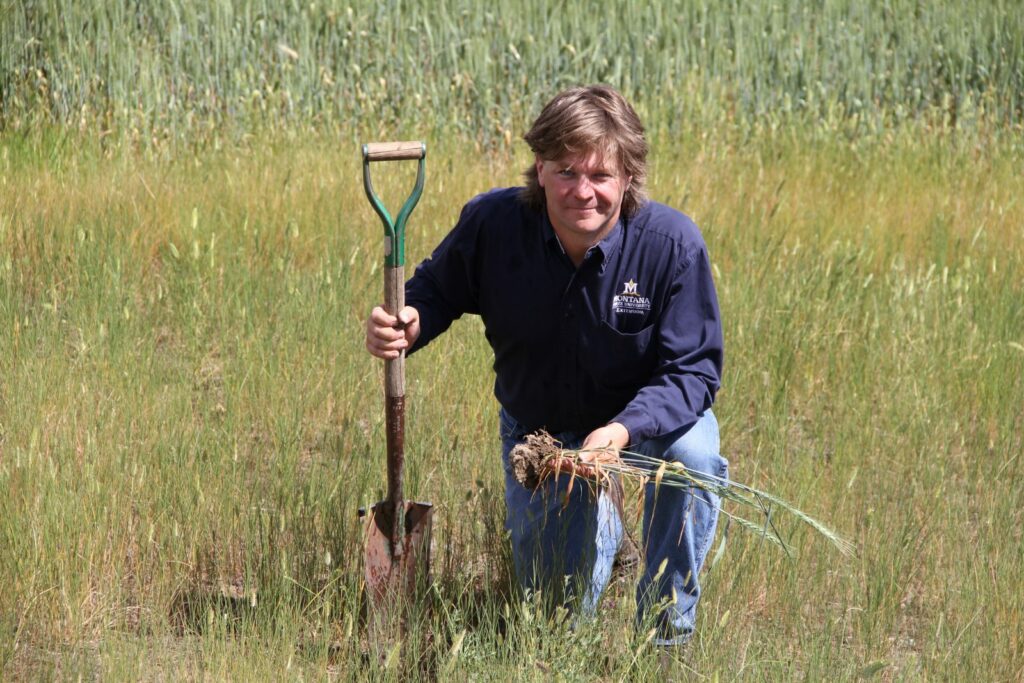Farmers are learning to live with these pesky pests as they head further north and west.
Wireworms are a diverse insect group, not a single species. There are more than 9,000 species worldwide, close to 900 species of wireworms can be found in North America. More than 30 different species are known to cause damage to U.S. and Canadian crops. While the larvae are persistent and hardy, the adults, known as click beetles, cause no harm.
“I am working in Montana in mostly cereal crops where we have a different set of wireworms than those found in the Midwest,” says Kevin Wanner, Montana State University assistant professor of entomology and an Extension specialist. “The pest’s biology can vary with different species. It is useful to know what species of wireworms are in your field.”

Wireworms have a multi-year lifecycle, living up to seven years in the soil before developing into the adult stage. The adults are only present for maybe three or four weeks in the spring, and it is during this brief stage that adult wireworms earn the name of click beetles. If you are walking through a field in the spring and see a black beetle about one-fourth inch long, you can verify whether or not it is a click beetle by turning it over onto its back. Adult wireworm beetles have a unique mechanism by which they pop themselves into the air to get back on their feet. This popping emits an audible clicking sound.
Wireworm Biology
Wireworm larvae are extremely hardy, and they eat almost anything. “They can feed on decaying organic matter, seeds and germinating
seedlings, plants and small animals, and facultative combinations of all three,” Wanner says. “Crop rotation is generally not an effective control because these insects have such a broad feeding habit.”
Wireworms are also tough and resilient, living in the soil for many years. Throughout the year, they move up and down in the soil profile as they seek more comfortable environments. In the winter they move deep into the soil to avoid freezing; in the spring, when the larvae are hungry, they are attracted by higher carbon dioxide content in the upper soil layers and move toward the soil surface in search of food as soil temperatures warm. As the soil’s surface layer dries out and gets hotter in the summer, the worms again move deeper into the soil to find moisture and escape the heat.
During the late summer when the larvae get large enough and prepare to pupate and become adults, they again return to the top 4, 6 inches of soil. Here they go through a short pupation and turn into adult click beetles in August and September. After mating, the females deposit from 200 to 400 eggs in the top 6 inches of the soil. The eggs will hatch into larvae within three to seven weeks. The young larvae overwinter in the soil and emerge the following spring to mate, after which the wireworm life cycle begins anew.
Depending on the species, the larvae will spend two to seven years living in the soil eating germinating seeds and seedling roots before they develop into adults. The shorter life cycle species tend to move around from spot to spot in a field and vary in severity from year to year. The longer-lived species tend to stay in the same spot and are less variable year to year. Once there is a significant number of wireworms in a field, they are likely to persist for many years.
Recognizing Damage
Wireworms are early season pests that can damage seeds, roots and developing seedlings, causing mortality and stunting which is often visible as a wilting flag leaf. Later in the season, when wheat plants are getting larger, you will see the flag leaf drying because the wireworm is feeding on the stem, according to Wanner. In fruit crops, wireworms will eat into fruit that touches the ground. They also damage other row crops and vegetable crops.
“These wily worms feed on the seeds before or just after germination,” Wanner says. “Once you have wireworms in your field, they will feed on whatever crop you plant. That is why crop rotation offers little protection.”
Scouting Practices
You can scout to determine if wireworms are present:
- Before crop emergence to determine economic thresholds. You can scout before planting, but your findings may be more variable because of the cold soil.
- After crop emergence to inform management for the next year.
- Use baits such as corn or wheat seed to attract wireworms. Soak seed overnight in water so it will germinate quickly. An ordinary sock makes an effective trap. Put the soaked seed bait in the sock and bury it 6 inches deep. Come back in 7 to 14 days — the seed will have germinated and it will attract wireworms.
- If you find wireworms, save some in alcohol to send to an entomologist to determine the species.
Cultural practices are generally not very effective. “Wireworms are a very difficult pest to manage,” Wanner says. “Continuously cropped irrigated wheat fields are at highest risk. Once a field is infested with high wireworm populations, most crops except alfalfa will be damaged.”
Management Tips
A 5, 7 year rotation with alfalfa will reduce wireworm population but will probably not eliminate the populations because the larvae feed on such a wide variety of material.
Plant spring crops later in the spring so the seeds will not be in the ground any longer than necessary for germination. Smaller seedlings are more susceptible to damage. Make sure fall crops are well established so they will grow quickly in the spring and have a better chance of outgrowing wireworm damage.
Regular irrigation keeps the surface soil moist and this allows wireworms to stay at the surface throughout the summer.
All About Control
Insecticide seed treatments to protect stand development and crop yield is the most effective control method. If more wireworms are found in the soil, Wanner recommends using a higher rate of seed treatment. If springtime scouting finds at least one wireworm in each trap, applying a seed treatment is recommended. If more than four wireworms are found, apply seed treatment at the highest labeled rate, and increase seeding rate to compensate for wireworm damage.

“There is no post-emergent insecticide option for wireworm control,” says Mitch Stamm, BASF biology project leader for seed solutions. “In terms of economic cost-benefit, wireworms are very hard to predict. When advisors give a recommendation for pest control methods, they like to have a reasonable degree of confidence of what the outcome will be. With wireworms, this is very difficult.”
Both BASF and Syngenta continue to research wireworms, and both have products in early stages of development.
Wireworms in 2018
Wireworm populations appear to be becoming more abundant and thus more of a problem, heading northward; they are also moving westward from Indiana and across the Midwest into the Great Plains. This increase in wireworm populations results from several factors.

“One reason for the increasing wireworm population is the elimination of lindane as a control method,” says David Belles, technical asset lead, Seedcare, Syngenta Crop Protection. “Although lindane provided effective wireworm control, its agricultural use was banned internationally in 2007.”
Other reasons contributing to increased wireworm populations include changing cropping practices. No till rotations, some erosion control techniques and the use of CRP land provide favorable wireworm habitat.
“Wireworms are a problem in the Pacific Northwest and are beginning to be a problem in other wheat growing regions,” says Stamm. “It is unclear whether this perception is due to an actual increase in wireworm populations problem, or because we are becoming more aware of wireworm damage.”
Stamm also notes that in North and South Carolina, farmers are bringing CRP land into sweet potato production where growers are seeing substantial wireworm damage.
Cover crops improve conditions for wireworms by providing an improved food source.
“Anything which improves soil condition also improves conditions for wireworms,” Wanner says. “A cover crop used for erosion control and then tilled or burned before planting is going to have a lot of decomposing organic matter that will be releasing a lot of CO2. This will draw wireworms toward the top soil layer. Growers need to consider how to manage the cover crop along with the economic crop they will be planting.”
While climate change and changing spring weather patterns have been credited (or blamed) for many environmental changes, these are not affecting wireworm populations. Except for drought; in arid regions wireworms still need some spring moisture to come up and feed.
“Because wireworms are below ground pests, we do not see anything in this spring’s weather that should concern us,” says Belles. “In areas where there is prolonged standing water due to heavy rains, the wireworms will not come to the surface because there is less oxygen in the soil. But as soon as that water goes down, they will come up and begin damaging crops.”
As weather affects soil conditions, the environment for wireworms is also affected. When soil temperatures reach to 50° F (10° C), wireworms become more active. There are no rescue treatments after the crop has been planted. If there is any upside to dry, hot soil as in a drought, it may be that in these conditions wireworms migrate down into cooler soil and cause less crop damage.
Because wireworms are below ground pests, they are well protected from potential predators. The most likely predation is to eggs on the surface. There are few if any native diseases that affect wireworms.
It is not known if wireworms have developed any pesticide resistance — their lifecycle and underground habitat make researching this question extremely difficult.
There is considerable genetic diversity among wireworms which means a single chemistry will most likely be unable to completely control these diverse pests. In one project, researchers documented a wireworm survived six months after being intoxicated by a chemical pesticide. It had stopped feeding and then recovered. In the short run, this was good for the crop as the wireworm became inactive, giving the crop a chance to become established. In the long run, however, it was bad news because the larvae was still there and could continue to survive into the next season.
Soil is not always a favorable environment in which to live for five to seven years. Over time, wireworms have adapted to survive in a wide range of unfavorable environments. This evolution has made wireworm larvae into a resilient and difficult to kill foe of crop production. Its persistence has not gone unnoticed by pesticide developers. Products are in the developmental pipeline that may eventually provide a measure of control.
WHERE ON THE WEB: To learn more, watch the Seed World Strategy webinar or listen to the podcast.










